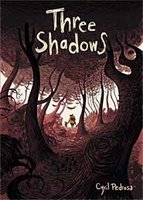
Three Shadows by Cyril Pedrosa is a very impressive work, the story of a father trying to deny his child's impending death. However, in spite of its appearance among the YA graphic novel finalists for the 2008 Cybils, I don't see how it can possibly be classified as YA. The story portrays an adult father going through various stages of grief over losing his young child. That's not a traditional YA theme. On a most superficial level, it doesn't even include any teen characters.
That doesn't mean the book isn't good.
Life is "simple and sweet" for Louis, Lise, and young Joachim until they notice three shadowy figures outside their farm. The figures, it turns out, bring death, and they are bringing it for Joachim. Lise wants to enjoy the time she has left with her son, but Louis takes his boy and runs. He's determined to save his child from death.
Sounds grim, doesn't it? Well, it is. But what it's not is maudlin. This isn't a manipulative weeper, trying to impress us because it's about death. I don't know if it's the supernatural element or the graphic format or just good story telling (through both text and art work, in this case), but Pedrosa treats his material as...oh, I don't know...maybe...literature? While many books about death, particularly a child's death, do little more than make readers feel badly, as if being able to move them to tears is an indication of the author's skill, Three Shadows seems to me to be an attempt to actually understand a life event through art.
Pedrosa is an experienced author of band dessinées, and his work in Three Shadows is very sophisticated. This is an excellent, adult work, and would make a great addition to a library collection of adult graphic novels.
Pedrosa has some interesting things to say about comics, which he holds in high regard:
"But in the past few years in France, as soon as a book of bande dessinée is something other than the 46-page color hardcover format I described, the book gets called a roman graphique, borrowing from the US term of graphic novel. I don’t know who the clever marketing whiz was that came up with the idea, but it’s clearly designed to lend a stamp of cultural approval by associating with novels, i.e. with “serious” literature for real readers, those with brains...
...Yet these “graphic novels,” as the term is used in France, owe nothing to the novel or to literature. They are pure, and often beautiful, comic books: the language they use, regardless of how inventive the forms used may be, is the language of comics. That’s what gives these creative works their power, and that’s what explains the very distinctive pleasure that their readers take in the process."
No comments:
Post a Comment